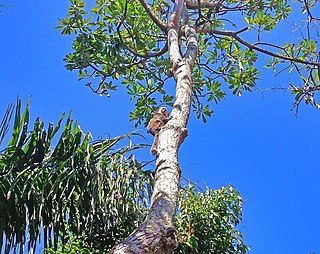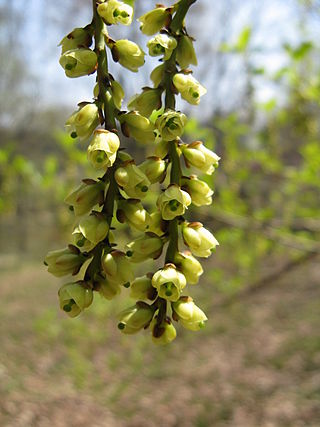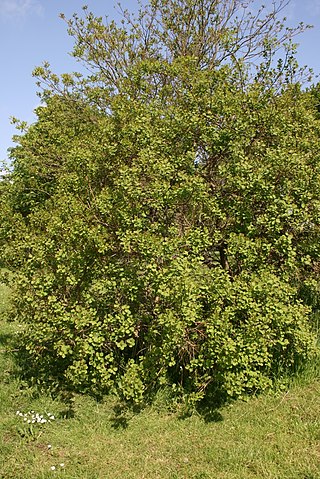
Plumeria, also known as frangipani, is a genus of flowering plants in the subfamily Rauvolfioideae, of the family Apocynaceae. Most species are deciduous shrubs or small trees. The species variously are endemic to the Neotropical realm, but are sometimes grown as cosmopolitan ornamentals in warm regions.

Cotinus, the smoketree or smoke bush, is a genus of seven species of flowering plants in the family Anacardiaceae, closely related to the sumacs (Rhus).

Leucopogon is a genus of about 150-160 species of shrubs or small trees in the family Ericaceae, in the section of that family formerly treated as the separate family Epacridaceae. They are native to Australia, New Zealand, New Caledonia, the western Pacific Islands and Malaysia, with the greatest species diversity in southeastern Australia. Plants in this genus have leaves with a few more or less parallel veins, and tube-shaped flowers usually with a white beard inside.

Adenanthos is a genus of Australian native shrubs in the flowering plant family Proteaceae. Variable in habit and leaf shape, it is the only genus in the family where solitary flowers are the norm. It was discovered in 1791, and formally published by Jacques Labillardière in 1805. The type species is Adenanthos cuneatus, and 33 species are recognised. The genus is placed in subfamily Proteoideae, and is held to be most closely related to several South African genera.

Himatanthus is a genus of flowering plant in the family Apocynaceae, first described as a genus in 1819. It is native to Panama and South America.
- Himatanthus articulatus(Vahl) Woodson - widespread from Panama east to French Guiana and south to Bolivia
- Himatanthus attenuatus(Benth.) Woodson - Venezuela, Colombia, N Brazil
- Himatanthus bracteatus(A.DC.) Woodson - Venezuela, Colombia, Guianas, Brazil, Peru, Ecuador
- Himatanthus drasticus(Mart.) Plumel - Guianas, Brazil
- Himatanthus lancifolius(Müll.Arg.) Woodson
- Himatanthus obovatus(Müll.Arg.) Woodson - Brazil, Bolivia, Guyana
- Himatanthus phagedaenicus(Mart.) Woodson - S Venezuela, NW Brazil
- Himatanthus semilunatusMarkgr. - Amazon Basin
- Himatanthus stenophyllusPlumel - Colombia, NW Brazil, Guyana, Suriname
- Himatanthus tarapotensis(K.Schum. ex Markgr.) Plumel - Colombia, Bolivia, Brazil, Peru, Ecuador
Himatanthus stenophyllus is a species of plant in the family Apocynaceae. It is native to Colombia, NW Brazil, Guyana, and Suriname.

Melicytus is a genus of flowering plants in the family Violaceae. Hymenanthera is a synonym.
Semecarpus obovatus is a species of plant in the family Anacardiaceae. It is endemic to Sri Lanka. The specific epithet was originally spelt obovata.
Trichocalyx obovatus is a species of plant in the family Acanthaceae. It is endemic to Yemen. Its natural habitats are subtropical or tropical dry forests and subtropical or tropical dry shrubland.

Adenanthos obovatus, commonly known as basket flower, or, jugflower, is a shrub of the plant family Proteaceae endemic to Southwest Australia. Described by French naturalist Jacques Labillardière in 1805, it had first been collected by Archibald Menzies in 1791. Within the genus Adenanthos, it lies in the section Eurylaema and is most closely related to A. barbiger. A. obovatus has hybridized with A. detmoldii to produce the hybrid A. × pamela. Several common names allude to the prominent red flowers of the species. It grows as a many-stemmed spreading bush up to 1 m (3.3 ft) high, and about 1.5 m (4.9 ft) across, with fine bright green foliage. Made up of single red flowers, the inflorescences appear from April to December, and peak in spring.

Elaeocarpus obovatus, commonly known as hard quandong, blueberry ash, whitewood, grey carabeen, freckled oliveberry or gray carrobeen, is a species of flowering plant in the family Elaeocarpaceae and is endemic to eastern Australia. It is a tree with buttress roots at the base of the trunk, egg-shaped to lance-shaped leaves with the narrower end towards the base, racemes of white flowers, and blue, oval fruit.

Elaeocarpus dentatus, commonly known as hinau, is a native lowland forest tree of New Zealand. Other names in Māori for the tree are hangehange, pōkākā, and whīnau.

Himatanthus bracteatus is a species of the genus Himatanthus (Apocynaceae), native Venezuela, Colombia, the Guianas, Brazil, Peru, and Ecuador. It is a shrub with oblong, obovate and acuminate leaves, white flowers in terminal corymbs and follicles with winged seed.

Stachyurus is the only genus in the flowering plant family Stachyuraceae, native to the Himalayas and eastern Asia. They are deciduous shrubs or small trees with pendent racemes of 4-petalled flowers which appear on the bare branches before the leaves. The plants have leaves with serrate margins.

Adenanthos sect. Eurylaema is a taxonomic section of the flowering plant genus Adenanthos (Proteaceae). It comprises four species, all of which are endemic to southwest Western Australia.

Cotinus obovatus syn. C. americanus, the American smoketree, chittamwood or American smokewood, is a rare species of flowering plant in the genus Cotinus of the family Anacardiaceae, native to scattered locations in Oklahoma, Texas, Arkansas, Missouri, Alabama and Tennessee. It is a deciduous, conical shrub growing to 10 m (33 ft) tall by 8 m (26 ft) broad, with oval leaves up to 12 cm (5 in) long. It produces panicles of pink-grey flowers in summer, and its foliage turns a brilliant scarlet in autumn; considered by many to be the most intense fall color of any tree. The smokey effect derives from the clusters of hairs on the spent flower stalks. It is highly sought after and cultivated in botanical gardens worldwide. It is dioecious, with male and female flowers on separate plants.
Monochilus is a genus of plants in the mint family, Lamiaceae, first described in 1835. It contains two known species, both endemic to Brazil.
- Monochilus gloxinifoliusFisch. & C.A.Mey. - Rio de Janeiro
- Monochilus obovatusP.D.Cantino - Goiás

Isopogon buxifolius is a species of plant in the family Proteaceae and is endemic to the south-west of Western Australia. It is an upright shrub with egg-shaped to elliptic or oblong leaves and clustered spikes of pink flowers.

Leucopogon obovatus is a species of flowering plant in the heath family Ericaceae and is endemic to the southwest of Western Australia. It is an erect shrub with hairy young branchlets, variably-shaped, simple leaves, and erect clusters of 3 to 15 white, bell-shaped flowers on the ends of branches and in upper leaf axils.














